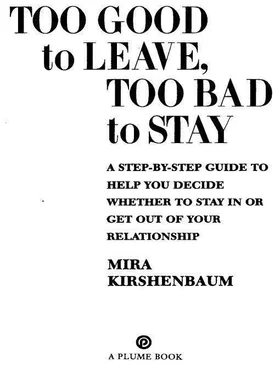Kirshenbaum, Mira - Too Good to Leave, Too Bad to Stay
Здесь есть возможность читать онлайн «Kirshenbaum, Mira - Too Good to Leave, Too Bad to Stay» весь текст электронной книги совершенно бесплатно (целиком полную версию без сокращений). В некоторых случаях можно слушать аудио, скачать через торрент в формате fb2 и присутствует краткое содержание. Жанр: Психология. Описание произведения, (предисловие) а так же отзывы посетителей доступны на портале библиотеки ЛибКат.
- Название:Too Good to Leave, Too Bad to Stay
- Автор:
- Жанр:
- Год:неизвестен
- ISBN:нет данных
- Рейтинг книги:3 / 5. Голосов: 1
-
Избранное:Добавить в избранное
- Отзывы:
-
Ваша оценка:
- 60
- 1
- 2
- 3
- 4
- 5
Too Good to Leave, Too Bad to Stay: краткое содержание, описание и аннотация
Предлагаем к чтению аннотацию, описание, краткое содержание или предисловие (зависит от того, что написал сам автор книги «Too Good to Leave, Too Bad to Stay»). Если вы не нашли необходимую информацию о книге — напишите в комментариях, мы постараемся отыскать её.
Too Good to Leave, Too Bad to Stay — читать онлайн бесплатно полную книгу (весь текст) целиком
Ниже представлен текст книги, разбитый по страницам. Система сохранения места последней прочитанной страницы, позволяет с удобством читать онлайн бесплатно книгу «Too Good to Leave, Too Bad to Stay», без необходимости каждый раз заново искать на чём Вы остановились. Поставьте закладку, и сможете в любой момент перейти на страницу, на которой закончили чтение.
Интервал:
Закладка:
GUIDELINE #16
If there’s something your partner does that makes your relationship too bad to stay in, and he acknowledges it, but he’s in fact unwilling to do anything about it, and if his unwillingness has been clear for at least six months, you’ll be happier if you leave. Quick take: If you’re waiting for your partner to want to change, you’re waiting for Godot.
This guideline is clear. When people are miserable in a relationship because of something the other person does and the other person is not willing to change, they’re usually satisfied with their decision if they decide to leave the relationship.
Sometimes you know your partner’s unwilling to change because he says so. Or because he shows you in a dozen different ways, like Peggy. But sometimes he says he’s willing but he’s not. If your partner is willing to change, he’s willing to do something to change. But do what? How does this work in practice if you’re in this situation?
Demonstrating Willingness
It really works when people come up with some specific idea of what it means for them for their partner to be willing to change and then they tell their partner what this is. They say something like, “This problem of yours makes me want to leave our relationship. You’ve said that you acknowledge that you have this problem. I’ll know that you’re willing to do something about it if you .. ,” and then they say what that something is. Clearly there’s got to be room for negotiation. You can’t just arbitrarily lay down the law. But your partner can’t just say he’s willing to change and then not do anything that demonstrates real willingness to you.
So how do you come up with this thing that demonstrates real willingness to you that you’ll tell your partner about? Since there are a million different problems and a million different reactions to each of these problems, all I can say is that whatever you come up with has to be real and specific and meaningful and observable. It’s got to be something that’ll actually make you firmly believe your partner is genuinely trying to change. It’s got to be some action about which you can say, “I know he’s willing to change because when he does that, I know he’s really trying.”
What kind of actions am I talking about? Here are some examples:
• For one person, a partner’s being willing to change with respect to substance abuse might mean going to some kind of AA-type meeting. For another person whose partner has the same problem, being willing to change might mean stopping hanging out with the same old crowd. Either way either person can say, “He’s really trying to change.”
• ∙ For one person, a partner’s being willing to change a pattern of earning little money and having long stretches between jobs—for whatever reason—might mean going back to school and getting some kind of skill or credential that will create good options. For another person whose partner has the same problem, being willing to change might mean taking that kind of serious real-world job they’d said in the past they’d never take and sticking with it for a year without getting fired. Either way either person can say, “He’s really trying to change.”
• For one person, a partner’s being willing to change being depressed, tired, and miserable much of the time might mean going into therapy and sticking with it. For another person whose partner has the same problem, being willing to change might mean going to a doctor and trying to get a prescription for an anti-depressant. Either way either person can say, “He’s really trying to change.”
Then you make an agreement about the specific change, which includes some kind of time frame. I’m talking about something like, “I’d like you to start doing this within a month and keep it up for a year. Not because I’m trying to boss you around or lay down the law but because it’s a simple fact that your not showing me you’re willing to change just makes the relationship too bad for me to stay in. That’s not a threat, it’s just my reality.”
The Waiting Trap
If you make an agreement you can save yourself from one of the many ways people fall into what I call the Waiting Trap.
We’re all susceptible to falling into the Waiting Trap all the time in our lives. Here’s an illustration of how it works.
Say you’re waiting for a bus. If you wait for ten minutes, you immediately convert that waiting time into a kind of investment. Because you’ve invested ten minutes in waiting for the bus, it feels stupid not to invest another ten minutes. Before you know it you’ve invested twenty minutes, and with an investment like that, how could you not keep waiting more and more. This is how you end up waiting forty-five minutes for a bus to take you somewhere you could walk to in fifteen minutes.
People do the same thing with problem partners. If you’ve waited a year for your partner to change, you’re almost magically drawn into waiting another year. And then how can you not wait two more years after waiting the first two years? Do you remember Sally from the beginning of this chapter? She was married to her alcoholic husband for thirty-two years because she was a victim of the Waiting Trap, wherein the more she waited, the more she felt she had to keep waiting to recoup her initial investment.
It’s to avoid the Waiting Trap that you specify a time frame when you talk about the specific thing you want your partner to do to show that he’s really willing to change. Some people hate the suggestion I’m about to make, but it’s really helpful to actually write down what your partner’s willing to do and the time frame on a dated piece of paper. Then you both sign it. (If he won’t even sign it, how can he be showing his willingness to change?) Then check in with this piece of paper a year (or however long you agree on) later. If he hasn’t done what the two of you have agreed, then he’s shown that in fact, regardless of his words, he’s unwilling to change and guideline #16 kicks in.
STEP #17: LETTING Go
Okay, so your partner isn’t willing to change and this problem is making you miserable. Here’s an option that never occurs to some people: it’s your just letting go of being bothered by the problem. Here’s the question for you:
Diagnostic question #17. This problem your partner has that makes you want to leave: have you tried to let it go, ignore it, stop letting it bother you? And were you successful?
I’m not talking about enduring the unendurable. I’m not talking about learning to live with suffering. I’m talking instead about something I’ve seen people do in the face of real problems, even in the face of problems that have bothered them for a long time. This problem that was attached to them like a ball and chain—they suddenly treat it like a helium-filled balloon they’re holding in their hand; they just let go and it flies away. They’re not enduring anything, because there’s nothing there anymore to endure.
Here’s an example.
John’s Story
Shortly after John moved to Boston from Texas for business, he met and married a woman who was a food writer and locally based editor of a women’s magazine. Because of what Beth’s work was about, John assumed that she’d be as traditionally oriented as he was. He understood that she’d continue to work professionally, but he took it for granted that she’d do most of the cooking and housework as well. He figured she’d want to.
Imagine John’s shock when he found that Beth was a slob, never did housework, and never did any cooking except for assignments. As his situation dawned on him he got more and more angry and disappointed, and they had bitter fights about “her” problem. She acknowledged that she didn’t do anything around the house and she expressed a kind of willingness to do more only in the sense that she said that if her schedule ever lightened up she’d do her fair share. Other than that she didn’t want to change.
Читать дальшеИнтервал:
Закладка:
Похожие книги на «Too Good to Leave, Too Bad to Stay»
Представляем Вашему вниманию похожие книги на «Too Good to Leave, Too Bad to Stay» списком для выбора. Мы отобрали схожую по названию и смыслу литературу в надежде предоставить читателям больше вариантов отыскать новые, интересные, ещё непрочитанные произведения.
Обсуждение, отзывы о книге «Too Good to Leave, Too Bad to Stay» и просто собственные мнения читателей. Оставьте ваши комментарии, напишите, что Вы думаете о произведении, его смысле или главных героях. Укажите что конкретно понравилось, а что нет, и почему Вы так считаете.












